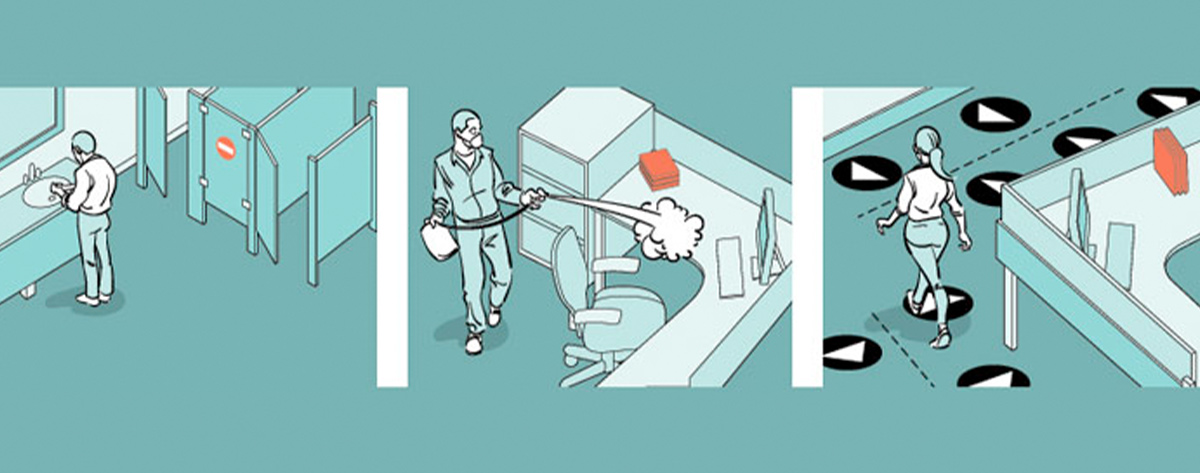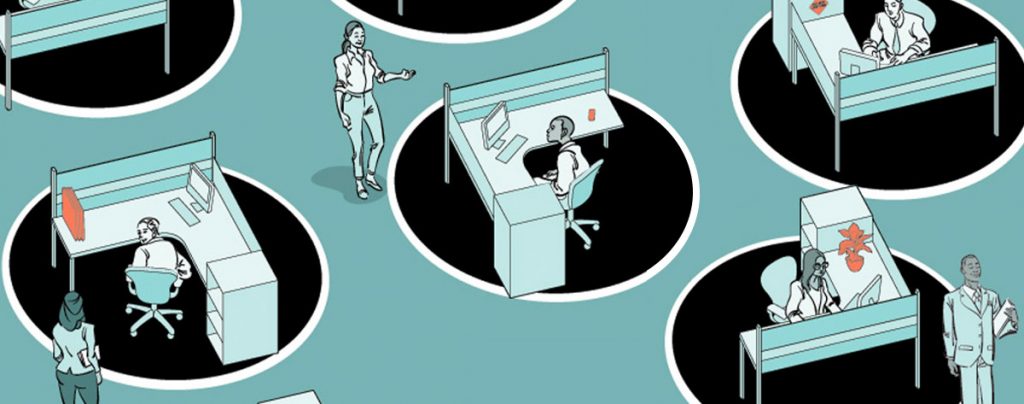By ADRIENNE TANNER
Workspaces will start to look a lot different because of the pandemic.
When Canada’s COVID-19 cases began to wane, building operators at the commercial real estate group Colliers ran the math on a key return-to-work factor: the time needed to empty a building with vastly reduced elevator capacity. As an example, the firm used an office tower with 2,000 employees and the requisite number of elevators, now restricted to carrying between two and four passengers per trip to maintain social distancing. The elevator would go to the top and stop at all floors on the way down where lines of people would be waiting at each one, says Colin Scarlett, executive vice-president with Colliers International Canada. The result was staggering. “It’s basically two and a half hours to empty the building out,” says Scarlett.
The elevator conundrum is just one of myriad challenges facing employers scrambling to provide safe working environments for returning office workers. Offices will require physical changes to keep employees farther apart and reduce the number of surfaces they touch. Staff may be required to wear protective equipment like visors or masks and shield shared workspaces with disposable cardboard covers. Arrows may be used to turn narrow corridors into one-way aisles.
“From day one, there’s going to be more open doors,” says Kristin Jensen, co-managing director of the architectural giant Gensler’s offices in Vancouver and Seattle. In washrooms, doors may be propped open until touchless technology is widely installed, and every other stall may be bolted shut for distancing. In-person meetings will be smaller and held in large boardrooms or open common areas with better air circulation. Approaches will differ from office to office, but one thing is certain: From the minute employees queue up to enter the building, everything about the office will look and feel different.
The most glaring difference will be how few people return. Two-metre physical distancing requirements mean fewer bodies at desks. Most companies are planning to bring back between 20 and 25 per cent of their staff in the first phase of return, says Samantha Sannella, Cushman & Wakefield’s managing director of strategic consulting in Toronto. “And I do think that 30 per cent of people will never return if there’s not a vaccine,” she adds. The global commercial real estate services firm has already published a 34-page guide that starts with a deep clean of buildings, including mechanical and air conditioning systems, moves to staff training so everyone understands the new ground rules, and then focuses on reconfiguring workstations to comply with two-metre social distancing.

It is possible to work safely in an office during this pandemic moment, says Lisa Fulford-Roy, senior vice-president, client strategy and senior managing director of workplace at the commercial real estate firm CBRE Canada. “But it’s very challenging.” So, most companies are calling back only those staff critical to the company’s operation who can’t work from home. “In most cases, workstations would not need to be moved,” Fulford-Roy says. “Social distancing can be achieved by occupying desks in a checkerboard fashion, alternating teams week over week in opposite seats.” Gensler has a computer program called ReRun that takes a client’s existing floor plan and, by changing the parameters, reconfigures workstations and hallways to comply with social distancing, Jensen says.
For clients seeking new space, Cushman & Wakefield has even designed a “6 Feet Office,” with generously spaced workstations. Carpet incorporating black circular designs around each desk serves as a visual reminder of the two-metre demarcation zone. Of course, existing offices can do the same thing with tape and probably will, says Sannella. Some businesses, like restaurants, will renovate for safety by installing Plexiglas dividers between booths and at cash registers. There will be far fewer renovations in office towers where most staff can work from home, she says: “I think people will be reluctant to spend most anything at all and cap expenses because everyone is just trying to keep their people employed.” Exceptions could include Plexiglas shields for receptionists who greet visitors face-to-face.
For those who return, signage showing staff where to walk and reminding them to distance will be important until people adjust to their new surroundings. One Scarborough, Ont., printing company, Proprint, recognized the looming demand and created an online ordering system to pre-sell signage kits for offices of all sizes. The kits, which include arrows for directional control, social distancing and handwashing reminders and signboards, are customized using corporate brand colours and logos. Proprint CEO Richard Krakower feels for company owners who have much to worry about as their employees return to work. “This is one quick way to ease some of that burden,” he says.
Perhaps the most fraught aspect of returning to the office is simply the air we breathe. We know that COVID-19 is particularly difficult to contain in indoor settings, where droplets can circulate without anywhere to go. Building owners may want to undertake more large-scale renovations, such as retrofitting heating, air conditioning and ventilation (HVAC) systems, and installing high-efficiency particulate air (HEPA) filters, which are designed to catch particles as small as 0.01 microns. Office managers may also want to invest in antimicrobial spray that coats and protects surfaces like desks and door handles from bacteria buildup. Some sprays can last on surfaces for up to a year.
“While the need for commercial space hasn’t disappeared, the kind of space being demanded will shift in a fundamental way”
The most challenging spaces to manage from an infection control perspective are common areas like washrooms and kitchens. According to Jensen, cleaning will increase, and schedules will shift. “We used to do all of the janitorial work at night,” she says. “More of that is going to happen during the day so that people can see that it is being cleaned.”
Looking ahead, the jury is out on whether office size will shrink or grow. “The movement for the last number of years has been to go smaller and smaller,” Sannella says. Now we may see less demand for small open-concept work environments and a return to private walled-in offices, which are more expensive to build and take up more space. However, if companies find they can maintain productivity with staff working from home, office size could stay the same or even drop.
Ultimately, it’s just too soon to predict how the pandemic will shape the demand for commercial real estate, says CPA Canada Chief Economist Francis Fong. “While it is likely that there will be less demand due to more people working from home, businesses may also demand more space to compensate for the fact that workers will need to allow for physical distancing,” Fong says. “The only thing we can say for certain is that while the need for commercial space hasn’t disappeared, the kind of space being demanded will shift in a very fundamental way.”
Jensen predicts companies will change their criteria when seeking new office space. “Tenants and companies are going to be as focused on the health certifications of space as they have been on the sustainability certifications,” she says. In some ways, tomorrow’s offices may look a bit more like home, with windows that open and more outdoor space. Despite the current health challenges posed by people working in proximity, most everyone is confident the office will survive, in one form or another. Scarlett says a Colliers survey conducted in March found 65 per cent of people working from home don’t have a dedicated workspace. The international survey, titled “Real-Time Data to Navigate the Post-COVID-19 Workplace,” drew more than 4,000 responses from 15 industries of various sizes. “So, the office isn’t going away,” he says. Jensen agrees and says the desire to work together in teams is elemental: “We still have that craving for a connection with others.”
This article was first published by CPA Canada. You can read the original version here.
